The Clocktower Building, 1 Main Street: Review and Ratings
between Plymouth Street & Water Street View Full Building Profile
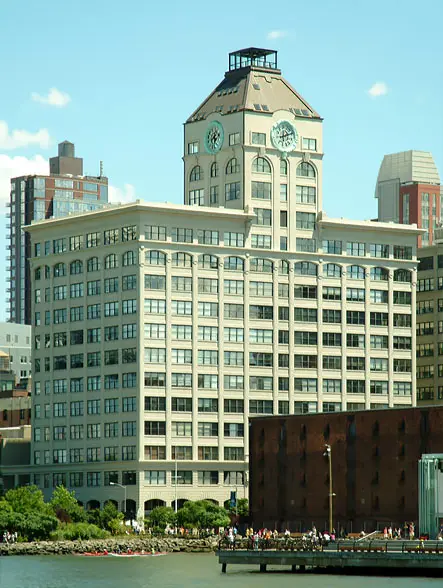

The Clocktower at One Main Street is a large, bulky building that is one of the most prominent in Brooklyn as it is just to the north of the entrance to the Brooklyn Bridge and commands truly breathtaking views of the bridge and the Lower Manhattan skyline.
It is the best and most impressive of the industrial buildings that make up most of the DUMBO (Down Under the Manhattan Bridge Overpass) riverfront cobblestone neighborhood around the Brooklyn and Manhattan Bridges.
It is a 12-story building between Plymouth and Water Streets and its central south façade is topped by a four-story tower with huge clocks on each of its sides.
The building was erected in 1914 as an industrial building for Robert Gair and was designed by William Higginson.
In 1998, it was converted to 124 residential condominiums by David Walentas, the head of Two Trees Management, who was the driving force in the residential conversion of this industrial neighborhood.
The building's official address is 1 Main Street and it is also known as 82-90 Plymouth Street and 97-111 Water Street. Mr. Walentas has called it the "Clocktower Building," the name by which it is popularly known.
Bottom Line
One of the most prominent buildings in Brooklyn, the Clocktower commands dramatic views of the Brooklyn Bridge and the Lower Manhattan skyline.
Description
"The austere concrete façade," a report by the city’s Landmarks Preservation Commission said, "articulated by large window openings, vertical piers, rusticated base, projecting cornice, prominent clock tower, and abstracted, classically-inspired detail, marks 1 Main Street as an example of the Industrial Neo-Classical style."
The report also noted that "1 Main Street was considered to be the tallest reinforced concrete building in the world at the time of its construction," adding that "it has 275,000 square feet of space and was supplied with three freight elevators and two passenger elevators."
Bubby’s restaurant is on the ground floor.
Amenities
The building has an entrance marquee, a 24-hour concierge, a gym and a roof deck.
It has arched windows on the 1st, 2nd, 11th and 14th floors and is pet-friendly.
Apartments
In 2008, the space within the four-story tower was put on the market for $25 million, the most ever asked for an apartment in Brooklyn.
An August 7, 2009 article by Josh Barbanel in The New York Times described the building's $25 million penthouse:
"The main floor of the sleek modern apartment is dominated by four working clocks housed in four-14-foot-high round windows, which provide nearly unobstructed views (except for the clock faces) out to the four points of the compass....The 3,000-square-foot main floor has an open living room, dining room and kitchen with 16-foot-high ceilings. A glass-walled elevator and a three-story floating staircase at the center of the space lead to smaller floors that narrow toward the top of the tower. There are three bedrooms on the 2,300-square-foot second floor (watch your head as your walk along the exterior walls), and on the floor above that, a 988-square-foot open loft with a 15-foot ceiling. Finally, up a narrow staircase at the very top of the building is a tiny windswept crow's nest. The apartment was created by David Walentas, the creator of the Dumbo neighborhood,...[who] converted it first into offices for the New York State Labor Department, and then, in 1998, into 124 condominiums. Mr. Walentas kept an apartment in the building, where he lives with his wife, Jane, as well as the apartment with the clocks on the 16th floor....The highest sale price on record for a home in Brooklyn as the $11 million sale of a house in Gravesend, a center of the Syrian Jewish community, and the highest price paid for a condominium was the $7 million sale of a 14th floor apartment at the Clocktower last year. That condo is now listed for sale at $8.5 million.
On August 10, 2009, Jose A posted a comment to this article that said "It’s like living in a batman movie," and “kellylc” commented "Just think, all the cash you would save never having to buy a watch again. This place would practically pay for itself!"
The apartment has a 24-foot-long "island" in kitchen designed by Stefano Venier at Miminal.
Apartment A in the center of the building facing Main Street has a foyer that passes an open kitchen with an island next to a 22-foot-wide dining room adjoining the 23-foot-wide living room. The two-bedroom unit also has a 19-foot-long home office.
Apartment D has a long entrance foyer that leads to a large 28-foot-long living/dining room with an open kitchen. The two-bedroom apartment has a 14-foot-long home office.
Apartment H is a two-bedroom unit with a 27-foot-long living/dining room with an open kitchen.
History
According to the historic district designation report of the Landmarks Preservation Commission, it is "the dominant building in 'Gairville,' the complex of factory structures erected in DUMBO by industrialist and real estate developer Robert Gair (1839-1927)."
"Gair was born in Edinburgh, in 1839 and came to America at the age of fourteen. He worked as a clerk in a dry goods store in New York City before serving in the Civil War (he reached the rank of captain). In 1864 he opened a business as a paper jobber in New York and then, in partnership with George West from 1867 to 1876, he began manufacturing paper bags with square bottoms. He also sold a wide variety of paper goods, many of which he also manufactured on machinery that he had constructed. However, it was Gair's inventions relating to the manufacture of corrugated paper boxes that resulted in his firm's growth. In 1870, Gair developed a machine for manufacturing corrugated paper and in 1879 patented a machine for creating folding boxes....The folding box soon became a basic material for the packaging of food (the National Biscuit Company was an early client). In 1888, as production grew, Gair moved his production from Tribeca to DUMBO.
“Gair's choice of a site on the northwest corner of Washington Street and Water Street was influenced by the recent move of his friend, coffee roaster John Arbuckle, to neighboring blocks....Like other manufacturers, such as Arbuckle, who moved from Manhattan to Brooklyn, Gair moved his family as well, purchasing a mansion on the corner of New York Avenue and Bergen Street in Crown Heights (demolished). The Gair firm expanded into the design and manufacture of a wide variety of packing products, including lithographed labels for cans and boxes....The 1901 Gair publication What We Do and How We Do It commented that 'the growing favor of canned and preserved food supplies, of boxed biscuits and wafers, has made label printing an object of greater consideration.'....The Gair firm became the largest manufacturer of paper boxes in Americas; in 1913, Gair employed 1,702 people in a complex of buildings that came to be called 'Gairville.'....In 1927, Gair production moved to Piermont, New York."
"By the second decade of the twentieth century," the report continued, "the major tenant in Gair's buildings was the Charles Williams Stores, a mail order supply business. The Charles Williams Stores was established by local coffee magnate John Arbuckle...in 1913 as a general mail order merchandising business. Arbuckle invented the name 'Charles William' expressly so that his name would not be associated with the business....By 1917, it was marketing itself as 'The Business that Serves the Nation,' one that 'brings New York to you.'...Using New York in its marketing was undoubtedly a device to separate this company from competitors such as Chicago-based Montgomery Ward and Sears Roebuck. In 1928, the business was purchased by National Bellas Hess, a company founded by H. Bellas Hess, a mail order merchant. National Bellas Hess was established in 1927 with the consolidation of the National Cloak and Suit Company and the Bellas Hess Company."
Mr. Barbanel’s 2009 article said that “Mr. Walentas's real estate company recently won approval to construct an 18-story building near the base of the Brooklyn Bridge over the objections of neighborhood residents, but Mr.Walentas said that the building would not affect the views from One Main Street..."
"The Walentas bet began 24 years ago," according to a July 7, 2005 article in The New York Sun by Pranay Gupte, "as a relatively small wager - at least as far as real estate deals go - when Jed's father, veteran developer David bought 2.5 million square feet in a largely decrepit industrial area known as Dumbo....He paid $12 million....It's a safe guess that David Walentas's original investment - in which Leonard and Ronald Lauder were partners - has already been recouped, probably several times over....David Walentas spent 17 years trying to convince the city to rezone the area for residential uses. Mayor Giuliani was instrumental in pushing through the rezoning in 1997."
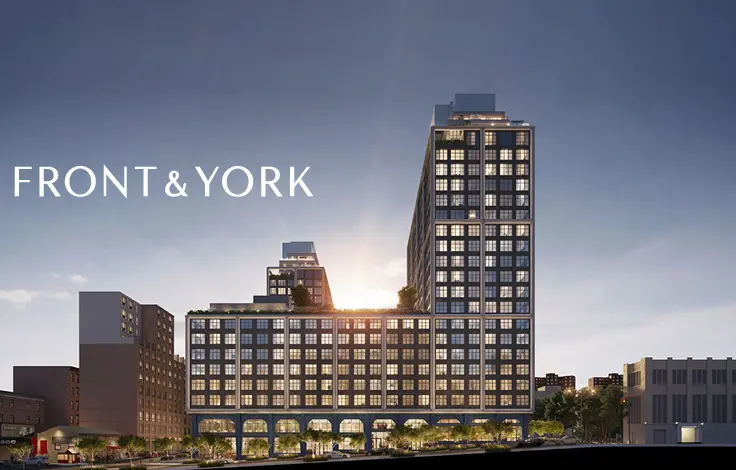
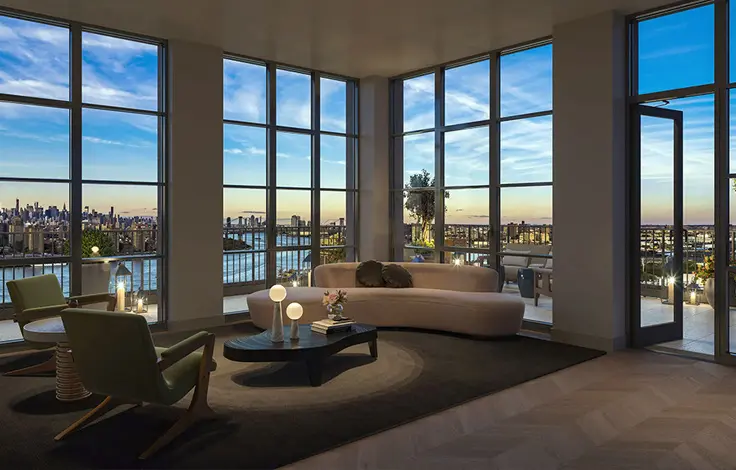

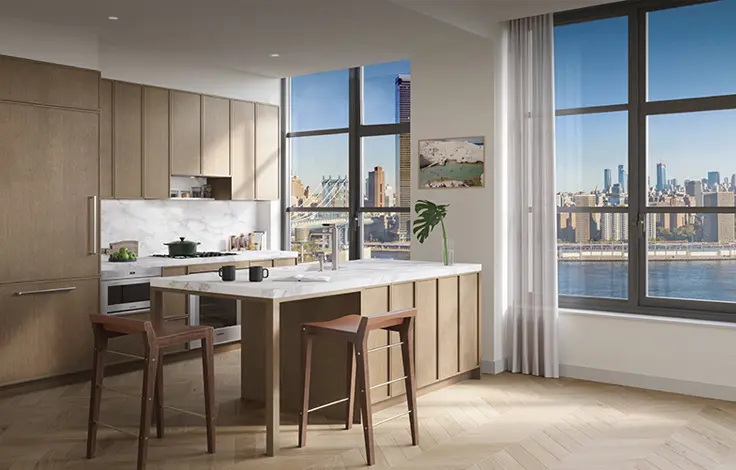
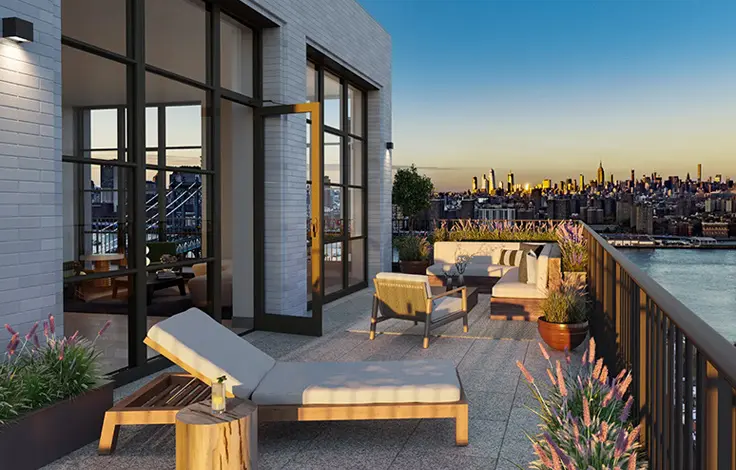
 6sqft delivers the latest on real estate, architecture, and design, straight from New York City.
6sqft delivers the latest on real estate, architecture, and design, straight from New York City.
